Such a thing as filler for a sofa plays a rather significant role, because the convenience of furniture and the duration of its service directly depend on it. The right choice determines comfort during sleep or sitting on this piece of furniture.
Species overview
The range of fillers is very diverse. They are selected taking into account the desired stiffness and the function performed by the given interior item.

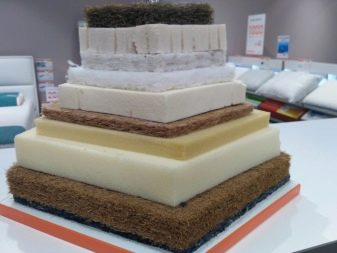
Spring loaded
Such fillers are in demand and distributed for a long time. They come in 2 types: dependent (or Bonnel) and independent (or Pocket spring).
Dependent
Spring-loaded device with a chain connection. Due to the frequency of the springs, this type is not able to distribute the weight as equally as a model with independent springs. This feature makes this option not very convenient, but its low cost makes it possible to fill budget soft furniture with it.

The degree of rigidity, as well as orthopedic characteristics, depend on the diameter and density of the springs per 1 m2. The most common models with 10-centimeter springs in diameter, where 100 pieces are located per square meter.
They are additionally coated with durable material, the rigidity of which depends on its type. Given this property, you can choose the optimal coating for individual tastes. To strengthen some units are provided with a metal frame, which increases the period of operation. This type of furniture is suitable for the living room.
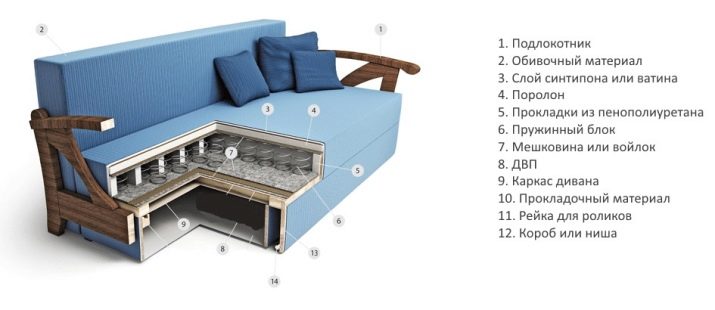
Independent
This type is made using innovative technologies. The springs are barrel-shaped, each placed in a dense fabric cover so that the connection between them is completely absent. The design makes it possible to quickly respond to a given load in a particular place.
A mattress with such a filler does not bend excessively and does not create noise. The price of this filler is much more dependent type, but the period of use is longer due to the additional coating and separate placement of the springs.


This filling option is optimal for the sofa, which is used for sleep. The advantages of the material include:
- long operation;
- reliability;
- lack of dents;
- the ability to choose the degree of rigidity;
- air circulation inside the filler eliminates the appearance of insects;
- orthopedic characteristics.


In addition to the many advantages, it is necessary to highlight some disadvantages:
- squeaking may occur after some time;
- high price for products with independent spring blocks;
- if the springs are damaged, repairs can be expensive.

Springless
Such fillers are made from a wide variety of materials that differ in both structure and characteristics.
Polyurethane foam
This synthetic highly porous filler is prepared by combining different polymers. The density of polyurethane foam can even exceed rubber and rubber, this property has a positive effect on the quality of goods from this material.
For furniture, a highly elastic polyurethane foam with a density of 30-40 kg per 1 m2 is used, and the larger the number, the longer the service life. PPU with a density index of less than 30 kg / m2 is used for the production of decorative pillows. Due to the simplicity of the technology for producing PPU, the price for it is quite budget.


Polyurethane foam can be of 2 types: cast and block. Under the influence of high temperatures and pressure, the initially liquid material acquires a solid structure and the exact dimensions of the necessary part. In this way, all the components of the sofa are made: the back, seat, side elements. The disadvantage of this filler is the formation of a sintered crust on the surface, as well as poor air circulation.
Block PPU because of the development method was called "sandwich" (several layers). It has the appearance of large sheets, varying in thickness and density. Different components are formed from them, which fasten several pieces with glue, which makes it possible to adjust the rigidity of the mattress and the height of the elements. For parts of the sofa, sheets of different stiffness are used.
It is important to prevent sunlight from entering the parts from the PUF, since under the influence of ultraviolet light they begin to crumble. Products made of polyurethane foam are covered with special lightproof covers.

Some PPU compositions are distinguished by the shape memory effect. This means that they can maintain the shape of the body and then adapt to them, which gives the rest maximum comfort. Then the material regains its primary position. Products with this filler are cheaper than with a spring independent unit, but are very similar in characteristics and comfort.
Foam mattresses can be used for daily sleep. Among the advantages of the material, it is worth highlighting that it is environmentally friendly and safe, hypoallergenic, does not accumulate dust, can withstand quite a lot of weight. When choosing, you should also consider that he is able to quickly lose elastic properties, which provokes the appearance of dents.


Synthetic winterizer
The most common species. Often used as a filler for budget items of furniture. Most often, this synthetic material is used together with some other filler, for example, with polyurethane foam, where a synthetic winterizer is placed between it and the upholstery. It adds furniture softness. The advantages of syntepon include the low price, environmental friendliness (fungus does not occur in the fibers), hypoallergenicity, and structure elasticity.
When choosing a sofa with such a filler, it is worth considering that the period of use is quite short.With regular loads, it loses its highly elastic characteristics and forms dents. In addition, you can often buy low-quality products, since there is no general technology for the production of synthetic winterizer.
As an independent filler, it is mainly used when stuffing pillows, as well as sofa backs, to give bends decorativeness. It is better to buy a sofa filled with padding polyester for the living room.



Periotek
Non-woven material is made using modern technology from high quality polyester fibers. It is mainly used for stuffing mattresses and upholstered furniture. The periotech is distinguished by sufficient strength, since both artificial and natural components are added in its production. Simultaneously with the strength, it is characterized by a long period of operation. To strengthen it even more often dense fabrics are used, for example, knitted doubler or coarse calico.
To determine the degree of rigidity of the perioteca, as well as its components, it is worth paying attention to its marking. The material is obtained through a special technology in which 3 layers of material are formed. The fibers of the first layer are formed vertically and fixed in this position using high temperatures. The other two are reinforcing layers that serve to strengthen the first. Such an unusual design contributes to very high rates of periotec as a filler.


This material is absolutely safe, since the composition does not contain glue, resins and other toxic components, it does not serve as a source of allergic reactions. A mattress made of such a material is characterized in that it keeps its shape well, even when exposed to a lot of weight. Due to the structure in several layers, the material can be used for a long time without losing its characteristics.
For some periopecks, it may seem somewhat harsh filler. You can make it softer by adding auxiliary materials. Furniture filled with perioteka is used for everyday sleep, since it is practically deformed.


Stratofiber
Modern material has a fairly elastic structure. It is made from fibers of various types (natural and synthetic) according to a technology reminiscent of perioteka production. The base layer consists of vertically folded fibers that are fixed by exposure to high temperatures. This technology is called "strutto" and gives the material a dense structure and high wear resistance.
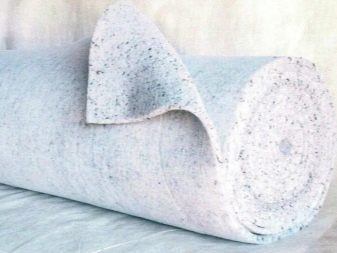

The filler reproduces the contours of the body, which has a beneficial effect on the spine during sleep. The following characteristics can be attributed to the features of this material:
- lack of predisposition to rot;
- long period of operation;
- quickly reproduces the original form;
- maintains decent loads;
- does not make unnecessary sounds;
- insects do not spread;
- low price.


Felt and padded jacket
First - natural non-woven material made from felted goat and sheep wool. Its structure makes it possible to obtain a fairly dense material under the influence of pressing at high temperature. Such material may have a different thickness, and in shape resembles a cloth. Padded jacket - it is a 5 cm thick cotton wool layer coated with a durable fabric. To connect, all layers are stitched with strong threads.
As independent fillers, these two types do not use, but felt is used as a protective cover for other fillers, and a padded jacket - as an intermediate between different fillers. They make the sofa more comfortable and soft. In addition, such fillers are characterized by protective properties, which increases the life of the furniture. Natural components do not provoke allergies, keep heat well.

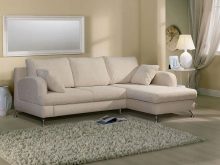

Importantly, felt and a padded jacket do not form dents, and their low cost makes them quite popular.Materials need frequent drying, as they are able to absorb moisture and can become moldy.
Hollofiber
This material can be called a modernized synthetic winterizer. Due to its spiral structure, the material is capable of very quick shape recovery even after significant loads. This feature is the main criterion when choosing a quality filler.
Pillows are often stuffed with raw materials in a ball-like form, whereas mattresses and sofas are filled with furniture holofiber, which looks like a thick, dense mat with a spiral structure. It is considered one of the highest quality fillers, especially due to its environmental friendliness and harmlessness.


Foam rubber
This is the most budget of all the fillers, in addition, characterized by low quality. In essence, this is the same PPU, but loose and low-grade. Most often it is used on the armrests. From the positive characteristics of foam rubber, one can distinguish a low price, harmlessness, anti-allergic properties, as well as air and moisture permeability.
Unfortunately, this material also has significant disadvantages: fragility, the rapid appearance of dents, moreover, it quickly dries up and loses its appearance. Mattresses, which are often used, do not fill with foam rubber, because they will soon acquire dents and lose aesthetic properties.


Latex
This filler is made of rubber juice and is filled with mostly expensive items of upholstered furniture. In its production, vulcanization technology is used, because of which the material is made durable and elastic. Latex is an absolutely natural product, durable and soft. In addition, it can last about 20 years without losing its original characteristics, and also has good orthopedic properties.
The specificity of production determines the rather high cost of latex filler. In addition to the natural material, artificial latex is also made, which can be distinguished by a yellowish tint and some dryness to the touch (the natural one has a grayish color and a somewhat greasy texture).
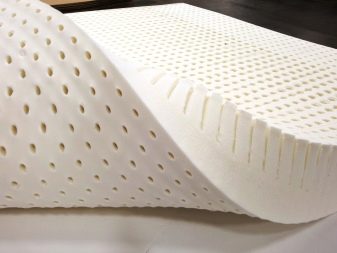
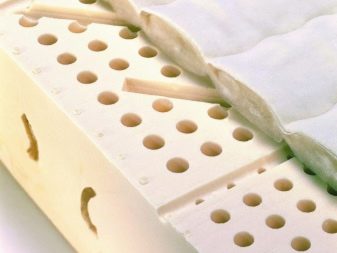
Durafil
The structure of the material is almost the same as the spring block. Durafil is a non-woven fabric of excellent quality, which is made from polyester fibers using a special technology, they have a vertical arrangement. This contributes to greater elasticity. It is great for sofas, adding softness to the seat and back. Durafil is distinguished by high hypoallergenic properties.
Due to the presence of vertical fibers, the material is able to quickly acquire its original shape, in addition, it stands out with its pleasant softness. It is worth noting that Durafil is resistant to temperature changes and dust collection, as well as antimicrobial features and a long period of use. A sofa with this content can be chosen for everyday sleep.


When choosing a sofa, you should pay attention to the presence of slats (slightly curved wooden planks). They serve as additional support and enable proper placement of the body, thereby performing an orthopedic function. They can be 2 to 10 mm thick. Strength and duration of use directly depend on these parameters, as well as on the frequency of the location.
Feature Comparison
To better understand the fillers and their features, it is worth considering their characteristics. Service life of materials:
- latex - about 20 years;
- Durafil, Strutofiber and periotek - from 10 years and above;
- spring blocks - from 7 to 10 years;
- polyurethane foam - 5-8 years;
- holofiber - from 5 to 10 years;
- foam rubber - up to 5 years.



Which is better to choose?
If you plan to buy a sofa on which they will sleep every day, then you should choose furniture with a spring unit, perioteka, PPU, dyural or latex. When choosing a sofa for sitting with regular loads, you should pay attention to the spring block, PUF, durafil, struttofiber, periotec or hollofiber.
Also quite often in furniture there is a stuffing with a combined composition, which makes it possible to achieve the ideal balance of comfort-quality-value.


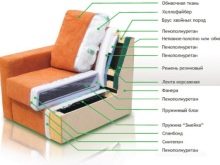
Replacement Rules
After a long period of operation, filling the sofa needs to be replaced. Foam rubber is most often chosen for this, as it is one of the safest and also cheapest fillers. To make it last longer, it is recommended to combine it with other types (spring unit). For furniture stuffing, 2 types of foam rubber are used: standard and high rigidity. It should be borne in mind that the material with greater rigidity will last much longer.
It is recommended to choose the material taking into account different types of sofas:
- for filling the sofa sofa, a continuous sheet of foam rubber 3-4 cm thick is optimally suitable, and to increase the terms of use, you can additionally take felt;
- for a sofa-book, foam rubber is taken both independently and in conjunction with a spring block;
- hard foam rubber is chosen for the corner sofa, and the backrest can be stuffed with material with a soft structure.



You can change the foam rubber as follows:
- the upholstery is removed or slightly opened;
- clean the old foam;
- if there are other fillers in the sofa (felt, sintepon) they should also be replaced;
- if there are no zippers on the parts of the sofa, you need to gently open the seams (after replacing them, they are sewn back);
- on the back, where there is a plywood substrate, you need to pull out the fasteners with an anti-stapler;
- the upholstery material is removed;
- on the old filler make a new pattern;
- sheets are cut out according to the pattern, put in place of the old ones and fixed;
- the upholstery (you can wash it first) is put into place, pressing the foam rubber at the same time - so the packing will straighten well and will be elastic;
- In this way they process all the details and assemble them in their previous position.




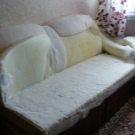

About what there are fillers for sofas, see further.










